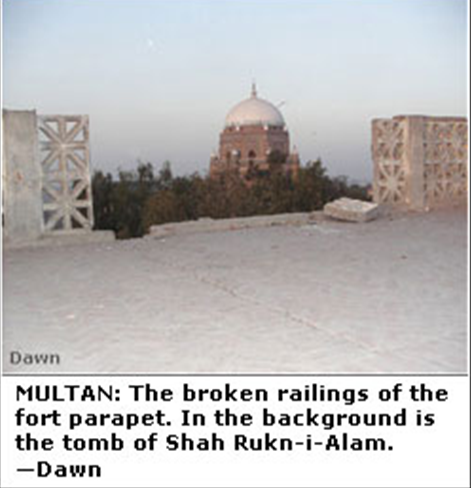Multan fort
This is a collection of articles archived for the excellence of their content. Readers will be able to edit existing articles and post new articles directly |
Multan fort
Multan fort falls to official neglect
By Shakeel Ahmad
MULTAN, Jan 17: The old fort of Multan, once considered one of the best in Asia because of its defence and architectural value, has become a glaring example of neglect of the authorities supposed to be taking care of the monument.
The fort, dating back to some period before the birth of Christ, is situated in the south-east of the old city on a high mound.
Historians agree that Alexander of Macedonia, who conquered Multan in 326BC, had faced severe resistance at the fort while he was fighting for the city.
Later, it was destroyed by the British invaders in 1848-49 to avenge the death of Lt Alexander vans Agnew, who fell victim to a poisoned arrow in Multan.
The present structure of the fort tell a tale of ravages of time, with its fenceless stairs leading to Damdamma (parapet) from where one can have a view of the city and relics of Perhaladpuri Temple.
But the overall condition of the fort shows that the time is not the only factor to be held responsible. The negligence and lack of concern on part of those assigned with the fort’s upkeep also account for its present state.
Despite repeated requests by Hindu community, nobody bothered to make arrangements for restoration and renovation of Perhaladpuri Temple, which is of great religious and historical importance.
As one climbs up the steep stairs leading to Damdamma, the fear of falling down always looms large as there is no fence on the left side, says Nuzhat Perveen, a visitor to the monument. Similarly, two large pools in the fort also lack maintenance, she adds.
Zahoor Dhareja, an intellectual and senior journalist, deplored that the monument was a victim of official neglect.
He said the condition of Damdamma showed nobody was interested in preserving the fort and added that Punjab government was spending billions of rupees on conservation of Lahore Fort while Multan fort had been left to the mercy of inefficient bureaucracy which did nothing but making superficial schemes to spend the meagre funds available for the monument’s upkeep.
He demanded that the matters regarding the restoration, conservation and renovation of the fort be handed over to a committee comprising members of local community, including the historians and archaeologists.
District Coordination Officer Sittar A Sheikh and District Nazim Mian Faisal Mukhtar were not available for their comments.
